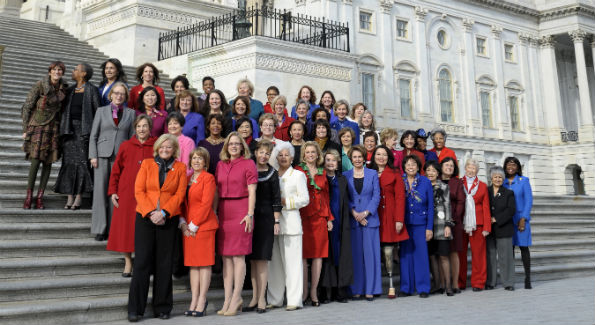An inside look at the barrier-breaking women of the 113th Congress.
By Sarah Valerio

The 113th Congress is comprised of more women than any of its predecessors, with 101 across both chambers. (AP Photo/Cliff Owen)
If there were indeed a “war on women” this past election cycle, whoever was waging it appears to be losing. The 113th Congress boasts a record number of women, with 101 across both chambers; 20 in the Senate and 81 in the House.
The women of the 113th, 16 Democrats and 4 Republicans in the Senate and 61 Democrats and 20 Republicans in the House, are far more than just a barrier-breaking statistic. While the majority of lawmakers sworn in last week were still white men, House Democrats became the first caucus in the history of either chamber to not have a majority of white men, and the new Congress now more accurately reflects U.S. diversity and demographics.
“To see a new class of freshman who come with such diverse backgrounds is really representative of what America is,” said Rep. Allyson Schwartz (D-Pa.).
The newly elected representatives include Sen.
Tammy Baldwin (D-Wisc.), the first openly gay senator, Rep.
Kyrsten Sinema (D-Ariz.), the first openly bisexual member of Congress, Sen. Mazie Hirono (D-Hawaii), the first Buddhist senator, and the first Hindu representative, Rep. Tulsi Gabbard (D-Hawaii). Gabbard joins Rep. Tammy Duckworth (D-Ill.) as the first female combat veterans to serve in Congress.
Sens. Elizabeth Warren (D-Mass.), who defeated incumbent Republican Sen. Scott Brown, Deb Fischer (R-Neb.), besting former Democratic Sen. Bob Kerrey, and Baldwin, beating out former Wisc. Gov. Tommy Thompson, won closely contested races to become the first women senators in their respective states.
New Hampshire voters sent Reps.
Ann McLane Kuster (D) and Carol Shea-Porter (D) to Washington and elected Gov. Maggie Hassan to become the first state with an all-female congressional delegation and governor.
“We’re always pleased to have more females in the body,” said Rep. Lynn Jenkins (R-Kan.). She elaborated on what she believes women will bring to the table saying, “we have different strengths. We’re very good at consensus building and getting to the bottom of a problem.”
2012 proved to be an election in which female voters were particularly decisive. While the predominant issue of the election cycle was the economy, “women’s issues,” including abortion, equal pay, access to birth control and contraception, and even rape, were also at the forefront of the discussion and of voters’ minds – especially female voters.
“Womens’ health, equal pay, equal opportunity – these are issues that affect men and women. And we [women] are now in increasing numbers a part of the debate,” said Schwartz. “Women bring a different perspective.
”
Jenkins echoed her sentiments virtually verbatim: “We have a different perspective.”
Though women are approximately half the U.S. population, “we’re still under 20% [of Congress],” said Schwartz, highlighting that while women have come a long way, there is still a long way to go.
But if there remains any lingering doubt that Rep.
Nancy Pelosi (D-Calif.), the first female Speaker of the House, didn’t break what she referred to as the “marble ceiling,” it now has 101 more cracks in it.
